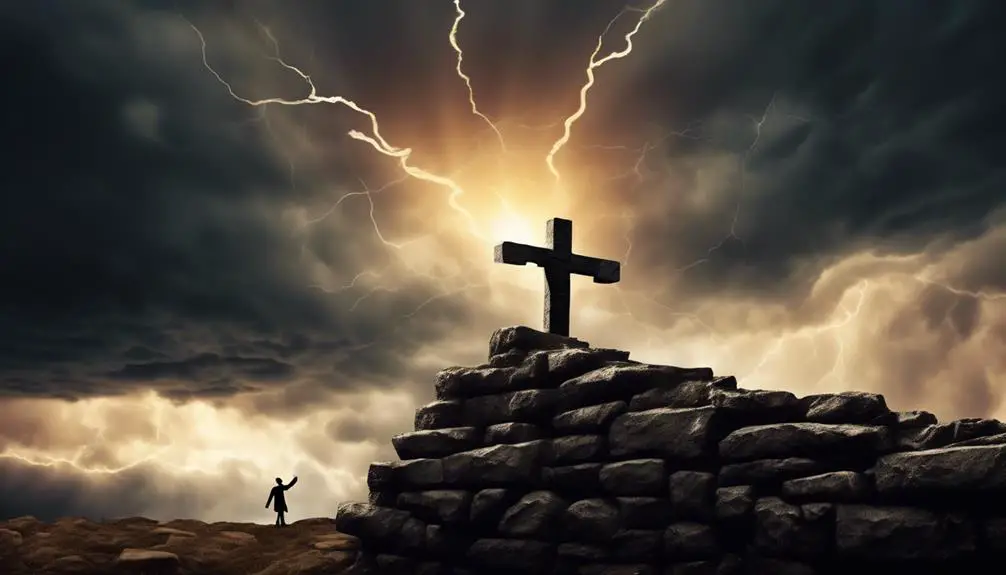An exploration of the biblical metaphor 'straddling the fence,' and its profound implications on spiritual indecision and commitment.

What Does Straddling the Fence Mean in the Bible?
In the realm of spirituality, clarity often emerges from ambiguity. You’ve likely heard the phrase ‘straddling the fence,’ but have you ever paused to consider its implications within a biblical context?
This metaphor, rooted in ancient wisdom, speaks volumes about spiritual indecision and the call to choose sides. The Bible carries numerous passages addressing this concept, each offering unique insights into the consequences and implications of fence straddling.
But what could it possibly mean for your spiritual journey? To answer that, we need to explore the origins and interpretations of this phrase within the holy scriptures.
How it may apply to you, well, that’s another profound question waiting for your discovery.
Key Takeaways
- Metaphors in the Bible, such as straddling the fence, are used to convey profound spiritual truths and concepts.
- Straddling the fence symbolizes a spiritual or moral divide, representing the call to make a clear choice in matters of faith.
- Spiritual indecision can lead to stagnation and distance from God, emphasizing the importance of committing to a specific belief or doctrine.
- Biblical guidance on decision-making involves trusting in God’s wisdom, seeking clarity through prayer and study, and bringing choices to God without anxiety.
Understanding Biblical Metaphors

To fully grasp the depth of biblical teachings, it’s crucial to understand the extensive use of metaphors within its texts, as these literary devices often encapsulate profound spiritual truths in an accessible, tangible manner. Metaphoric interpretations offer a lens through which you can examine and comprehend the symbolic language of the Bible, thereby providing a deeper understanding of its teachings.
Consider the parable of the sower, for instance. The seeds represent the Word of God, and the different types of ground symbolize varying responses to that Word. The thorny ground, for example, is a metaphor for those who let worldly anxieties and materialistic desires choke out the Word. This metaphor isn’t merely a narrative tool; it’s a representation of spiritual realities, painting a vivid picture of abstract concepts.
You’ll also find metaphoric language used to portray the characteristics of God. In Psalm 18:2, God is described as a rock, a fortress, and a deliverer – metaphors that emphasize His strength, protection, and salvation. Such symbolic language provides a way to comprehend God’s nature, which is otherwise beyond human understanding.
Furthermore, metaphoric interpretations allow you to connect the spiritual realm with your everyday life. In Ephesians 6:11-17, the Apostle Paul uses the metaphor of the armor of God, encouraging you to put on spiritual armor to stand firm against evil forces. This metaphor serves to illustrate the spiritual battle you face, urging you to equip yourself with faith, truth, and righteousness.
Origin of ‘Straddling the Fence

Building upon this understanding of biblical metaphors, let’s now explore the origin of the term ‘straddling the fence’, another metaphorical expression with roots in the Bible. This phrase isn’t explicitly found within the Bible’s text, but the concept it represents is deeply rooted in biblical teachings.
The fence symbolism is crucial to fully grasp the metaphorical origins of ‘straddling the fence’. In biblical times, fences were physical structures that marked boundaries. They separated livestock, divided property, and in a broader sense, denoted a clear distinction between two areas or concepts. As such, the fence in this metaphor signifies a spiritual or moral divide.
The act of ‘straddling’ the fence, then, suggests a position of indecision or neutrality, an inability or unwillingness to commit to one side or the other. This idea aligns with various biblical teachings that discourage lukewarm faith or a divided allegiance. For instance, in the Book of Revelation, the Laodicean Church is rebuked for being ‘neither cold nor hot’ (Rev 3:15-16). Similarly, the Gospel of Matthew warns against serving two masters (Matt 6:24).
Thus, while the term ‘straddling the fence’ isn’t explicitly biblical, its origin can be traced back to the Bible’s teachings on commitment and decisiveness. It’s an apt metaphorical representation of the biblical admonition against spiritual indecisiveness and the call to make a clear choice in matters of faith.
Spiritual Indecision Explored

Delving into the concept of spiritual indecision, you’ll find it’s a recurring theme in religious teachings, particularly in the Bible, that urges followers to make firm commitments in matters of faith. Defined as wavering between different religious beliefs or doctrines, spiritual indecision often stems from confusion, skepticism, or the inability to reconcile contrasting teachings.
The Bible frequently underlines the gravity of indecision consequences. It presents spiritual indecision as a precarious position, warning that it can lead to spiritual stagnation and distance from God. Revelations 3:15-16 admonishes the lukewarm, those who are neither hot nor cold in their faith, indicating the spiritual dangers of being undecided or half-hearted.
Spiritual commitment, on the other hand, is presented as an essential virtue. It involves dedicating oneself wholly to God’s teachings and following them unwaveringly. This commitment doesn’t leave room for indecision but calls for steadfastness, even in the face of trials or opposition.
Interestingly, the Bible doesn’t merely warn against spiritual indecision; it also provides pathways out of it. The process of seeking wisdom, understanding, and clarity through prayer and study is highlighted as a way forward. James 1:5 encourages believers to seek wisdom from God, who gives generously to all without finding fault.
Biblical Passages on Decision-Making

Shifting our focus from the perils of spiritual indecision, let’s now examine specific biblical passages that offer guidance on decision-making. The Bible, rich with Divine Guidance, provides a wealth of wisdom on how to navigate life’s choices.
Consider Proverbs 3:5-6: ‘Trust in the LORD with all your heart and lean not on your own understanding; in all your ways submit to him, and he’ll make your paths straight.’ This passage emphasizes the importance of trusting God over our own limited understanding. When you’re confronted with a difficult decision, rather than straddling the fence, the scripture urges you to rely on God’s wisdom.
In James 1:5, the Bible further instructs: ‘If any of you lacks wisdom, you should ask God, who gives generously to all without finding fault, and it will be given to you.’ This passage embodies the concept of active seeking of Divine Guidance. It reiterates that God’s wisdom is available to all, and encourages you to actively seek it in situations of uncertainty.
Finally, let’s look at Philippians 4:6: ‘Do not be anxious about anything, but in every situation, by prayer and petition, with thanksgiving, present your requests to God.’ This scripture not only provides a method for decision-making, but also a soothing reassurance. It teaches that you shouldn’t be anxious about your choices but rather bring them to God in prayer, demonstrating an attitude of gratitude.
These passages, when taken together, paint a clear picture of Biblical Wisdom on decision-making: Trust in God, actively seek His wisdom, and bring your choices to Him in prayer.
Dangers of Fence Straddling

While the Bible offers clear guidance on decision-making, it also starkly illustrates the potential dangers of fence straddling, highlighting the spiritual peril that comes with indecision and lukewarm commitment. The Bible doesn’t merely advise against this indecision; it warns of the negative consequences that stem from this moral ambiguity, cautioning that a wavering commitment can lead to spiritual downfall.
The moral ambiguity that comes with fence straddling can lead to confusion and a lack of clarity in one’s spiritual direction. This can, in turn, make it difficult for you to decipher right from wrong, blurring the line between sin and righteousness. This ambiguity can also lead to a spiritual drift, causing you to stray further from your faith, leading to a life that’s not rooted in the principles of the Bible.
Moreover, the fluctuations in faith that come with fence straddling can further exacerbate this issue. A faith that’s inconsistent and fluctuates between strong belief and doubt can weaken your spiritual backbone. It can cause you to question the tenets of your faith, leading to a spiritual crisis that can be hard to navigate. The Bible emphasizes consistency in faith and warns against such faith fluctuation.
In essence, the dangers of fence straddling emanate from the moral ambiguity and faith fluctuation it introduces into one’s life. It’s not just a matter of being indecisive; it’s about the spiritual consequences that come with this indecision. It’s a risk to your faith, a threat to your spiritual integrity, and a path to potential spiritual jeopardy.
Choosing Sides in Faith

Recognizing the perils of straddling the fence, it becomes crucial for you to make a decisive stand in your faith, opting for a clear, unwavering commitment to your spiritual beliefs. This faith commitment isn’t merely a one-time decision, but rather a continuous, steadfast dedication to your religious convictions. It requires the resolve to resist religious ambiguity and the fortitude to confront potential challenges to your faith head-on.
Religious ambiguity can often result in a diluted faith, where your spiritual convictions might teeter precariously on the edge of doubt and uncertainty. You could find yourself wavering between different religious doctrines, unable to firmly maintain your faith commitment. This state of indecision not only weakens your spiritual integrity but also leads to spiritual stagnation.
To avoid this, it’s essential to fully immerse yourself in your faith, immersing yourself in the teachings and doctrines that form the bedrock of your belief system. This requires not just knowledge of your faith, but also the practical application of its principles in daily life.
Choosing a side in faith isn’t about picking one religion over another, nor is it a question of right or wrong. It’s about choosing to live a life that’s consistent with your core beliefs, and accepting the responsibilities that come with that commitment. It’s about renouncing the comfort of sitting on the fence and embracing the challenges and rewards that come with a firm faith commitment.
Ultimately, your faith commitment is a reflection of your spiritual identity. By choosing a side in faith, you’re not only making a decision for yourself, but you’re also affirming your place in a wider spiritual community, contributing to its strength and continuity.
Personal Reflections and Applications

As you grapple with the concept of straddling the fence in faith, it’s worth reflecting on how this principle applies to your personal spiritual journey. Reflection techniques can be instrumental in shedding light on your stance. You might, for instance, ponder on instances where you’ve been torn between worldly desires and spiritual convictions. Do these instances indicate a pattern of fence-straddling, or do they rather signify growth periods in your faith journey?
Delving deeper, consider the feelings these instances have stirred within you. Is there a sense of unease, guilt, or confusion? These emotions could be indicative of the ‘fence-straddling’ principle at play, pointing to an inner struggle between two opposing forces.
However, translating these reflections into practical applications presents its own set of challenges. Application challenges may include the difficulty in breaking away from the comfort of the middle ground or the fear of fully committing to one side. These challenges, while daunting, aren’t insurmountable.
In dealing with application challenges, it’s crucial to remember that faith isn’t a static state but a dynamic process. It’s about making continual choices that align with your spiritual convictions, even when it’s difficult. Consider how you can apply the insights gained from your reflections in your day-to-day life. Can you identify specific actions or decisions that would reflect a move away from fence-straddling?
Conclusion
In conclusion, ‘straddling the fence’ in a biblical context signifies spiritual indecisiveness. As explored in various biblical passages, this stance can lead to spiritual peril.
It’s essential to make definitive decisions in faith, to avoid being lukewarm. Reflect on this metaphor in your personal faith journey.
Remember, choosing a side signifies commitment and dedication, crucial tenets in any spiritual journey.



Sign up